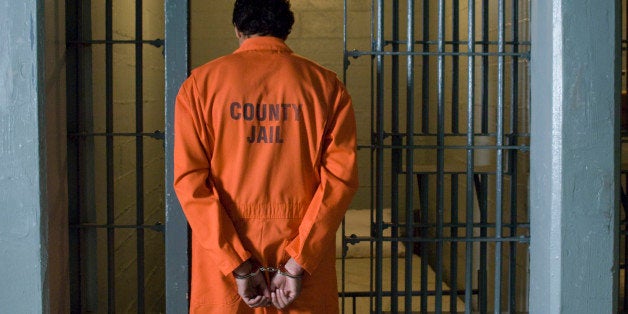
With the recent spate of prison bus crashes, it's time to look into the operating and safety methods being employed when prisoners are in transit. In January, a prison bus slid off a slick Texas highway, skidded down a hill and crashed into a freight train, killing eight shackled prisoners and two correctional officers; and just this summer in Arizona, a prison bus carrying 50 inmates slammed into a rolled-over semi truck trailer. No one was killed in the crash, but 20 prisoners and a guard were injured.
As our nation's politicians, from the president down, contemplate overhauling our country's criminal justice policies, a serious look needs to be taken at how prisoners are transported. Because with the lack of uniform regulations, insufficient correctional officer training and security trumping safety at all times, it's amazing there haven't been more fatalities. In the federal system, prisoners call transit "diesel therapy" and it's one of the worst aspects of being locked up. Nobody looks forward to a transfer from one prison to another and transit is the reason why.
William Salee, who is doing 18 years on a cocaine conspiracy, tells me:
I spent almost 10 years behind the same fences. So when I was transferred to the transfer center, it was the first time I was in a moving vehicle in 10 years. I was watching the fences and cars go by and I got a little car sick, and as we got on the freeway and started going faster the sickness got stronger. Then all of a sudden the bus swerves from one lane to another and everyone yells. A dude taking a piss fell over and pissed all over himself. All you could see in the big-ass bus windows was two huge semis speeding past us on both sides of the bus; I mean within inches of the bus. Everyone was freaking out, thinking we were going to die, and I thought, "Great, I finally get out from the fence and I'm going to die."
Fortunately, William didn't die and made it to his next facility but from the news reports above you can see not every prisoner is so lucky.
I have been on many prison buses and I can tell you the guards driving the bus drive very recklessly. They take curves at dangerous speeds and don't account for the prisoners being handcuffed with a belly chain around their waist and shackled with no seatbelt. It's kind of like how they put Freddie Gray in the back of that police van in handcuffs without securing him and then drove crazy so he got banged around. And you saw the result of that.
And if you are a big dude or overweight, the prison transit process can be difficult to say the least. Fridge, a 6-foot-4, 350-pound convict, who completed 19 calendars in the feds on crack cocaine and gun charges before being shipped into the Ohio State system to finish his time, says:
Federal transit is super hard on fat people, so hard in fact that I stayed in USP Lee for 10-and-a-half years to avoid it. You wake up early as hell, sit for hours in one spot, then you are belly chained, handcuffed and leg-ironed for hours, and that's before you hit the bus. And let's not even talk about the plane. That piece of shit had duct tape on the windows and the wings. I went back to court in 1999 on appeal and the plane broke down, but instead of landing it they pushed on to Kentucky, then emptied the whole plane out. Fuel was leaking from the wing of the plane. But the kicker is the tall-ass pilot. Dude walks with a severe limp like he'd been shot down or crashed over and over again. But he whips that plane like a pimp in a 7-duce 'llac.
Everybody has seen Con Air, but for real, it's not like that. The planes are like regular passenger planes and they have extra seats so they can fit as many prisoners in there as possible. We would be jammed in the bus and the plane like sardines. At least in the plane they would have a seatbelt for you to wear. Being in transit was long days, sometimes 14-16 hours of being chained up. On a bus, on a plane, on another bus, finally reaching the transit center, which is like a country jail, or hitting the pound where you were designated. After a long trip like that, hitting any yard was like paradise. But in prison you learn to appreciate the little things.
It was also rumored that all the planes we were flying around in were either seized from drug dealers or smugglers or were airline rejects. I don't know the truth of that but the planes did look raggedy like Fridge remembers. And the pilots seemed like rejects too. Dudes would claim that they couldn't fly on the regular airlines because they were drunks, or that they got suspended due to dangerous habits. Who knows the truth, but just like the guards driving the buses these dudes seemed like cowboys.
All the planes in the federal system are manned by US Marshals who work for the Justice Prisoner and Alien Transport System (JPATS). They transport over 280,000 prisoners a year in coordinated movements involving a fleet of airplanes, cars, buses, and vans. But the Bureau of Prison usually provides ground transportation to the local airport before handing prisoners over to the US Marshals.
"I got to admit, my first experience with the federal prison transportation system soured any desire I had to transfer to another prison, whether it was closer to home or not." Jesse Jongeward, who is at a halfway house now after doing close to a decade in prison for a drug conspiracy, tells me. "It is a maddening process dubbed by most of us convicts as 'diesel therapy.'"
Jesse relates how it all started for him in a white jumpsuit five sizes too big, shackled from waist to feet in the middle of a midwestern winter, no coat, and his ankle cuffs were cutting into his skin because he was wearing short socks that provided no comfort from the cold, metal leg cuffs. They stuffed Jesse and seven other prisoners in a small white van while it was still dark outside in the early morning and shuttled them six hours away to the nearest airport. Upon arrival they sat in the van until a call was made on the guards' radio signaling them to make their way to the tarmac where they were brought up to an old beat-up 747.
"Stepping up to Con Air was just like the movies," Jesse says.
Armed guards yelling at you as you're standing there in the freezing cold. Being that I had been on the road all morning, I really needed to use the bathroom and as we were led up the stairs of the plane, still shackled of course, I asked the guard if I could use the toilet. To which he responded, "As soon as we get in the air." Which ended up being two hours later, after everyone was loaded on the plane.
With security concerns overriding everything else when prisoners are transported, any comforts or even human decency is not allowed. I transferred to eight different prisons during my tenure in the BOP and I became a pro at transit. I didn't eat and drank water very minimally so that I wouldn't end up in situation like the one Jesse found himself in.
When I finally did get to take a leak the officer escorted me back to the open faced toilet. He proceeded to stare straight at my junk, conveying a creepy and uncomfortable feeling that could stifle the most confident and well-endowed man on the planet. I couldn't even piss. In the end, we flew a solid eight hours in that old rickety 747 and I still didn't get to my destination. I ended up in a little hole-in-the-wall federal holdover called the Grady County Jail in Texarkana and spent the next two weeks there before being moved by bus to FCC Forrest City.
The feds do that a lot, just dump prisoners in county jails that they have contracts with for bed space. They might leave you there for a night or longer. There is no rhyme or reason to their supposedly coordinated efforts. After years of being in the system and being transferred to different prisons across the country, I equate the BOP's and US Marshal's coordinated movements in prisoner transit to a form of organized chaos. But not all experiences in transit are bad.
"My best trip was in California when I was traveling from USP Lompoc to USP Atwater, a nine-hour drive by bus," Kevin Smith, who did a decade for possessing bomb-making materials and is in a federal halfway house now finishing up his sentence says.
The stares you get from every passerby like we're dangerous, or "Hey, let's look at the felons," gets old. But on this trip these two chicks in a convertible blew past us and, of course, all of us... are gawking through the mirrored tint windows. Once past us, they realize that we are a bus full of inmates. They slow back down to the side of the bus and the chick in the passenger seat stands up in her seat and pulls her shirt up. Wow... she kept it up for all of the bus windows to go by her car. What a wonderful woman. Some mama sure raised her right. One day I would really like to see her and personally thank her; not anything sexual. Just something like, "You sure made a lot of men that were in a bad place feel special again, just for a brief moment, thank you." It was worth all the hateful stares I've ever gotten on these trips.
Because at the end of the day, prisoners are just people too and they need to be treated accordingly. You are in prison to serve time for your crimes, not to die because a bus driver doesn't take his job seriously or is not qualified to be driving a bus, or drives fast and recklessly or thinks it's funny to have the inmates falling out of their seats on every turn. Too many guards who are charged with protecting the public and safeguarding prisoners treat their job like a joke and that is why we have tragedies and accidents like those highlighted above. As we reform our criminal justice policies, let's also look at every aspect of captivity because the prison transit system needs an overhaul too.
